
CRISIL Research expects domestic demand for petrochemicals, to grow at a compounded annual rate (CAGR) of 8-9% between fiscals 2018 and 2023. Demand grew ~8.5% on-year in fiscal 2018, owing to healthy offtake from end-use segments. Long term demand will remain robust from major consumer segments such as packaging, automobiles, consumer durables, construction, and irrigation. Demand growth could also arise from continued substitution of metal pipes with plastic pipes, and glass and metal containers with plastic containers. Increasing use of plastics for packaging due to its superior quality and cost-effectiveness will also contribute. Domestic petrochemicals capacity, however, may not keep pace. It is expected to expand at 4-5% CAGR between fiscals 2018 and 2023, vis-à-vis 8-9% demand growth.
India is a net importer of most polymers. In fact, import dependency for polyethylene (PE) and polyvinyl chloride (PVC) was 37% and 55%, respectively, in fiscal 2018. This provides enormous opportunity for players to expand existing and add new capacities. In the past, scope for polymer capacity addition was constrained by the unavailability of feedstock olefins, owing to lack of sufficient cracker capacity. Cracker capacity addition has challenges, such as high capital cost and cost competitiveness.



Comments are closed.